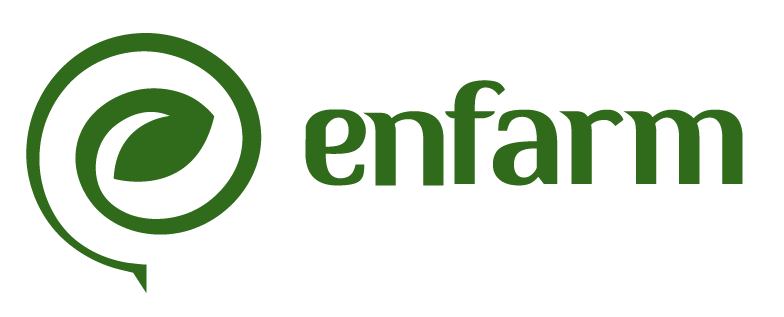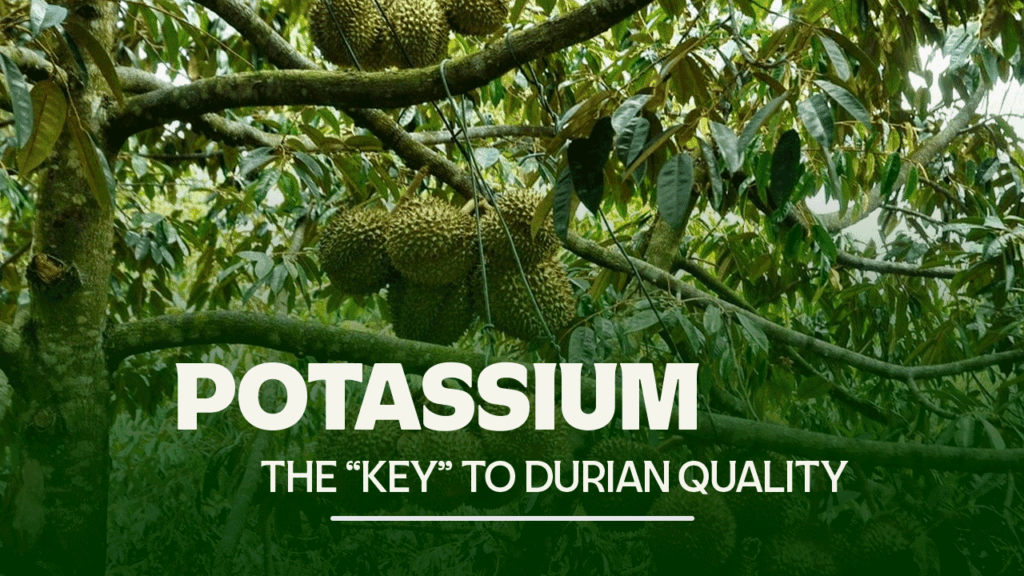An internal Enfarm survey of 30 durian orchards in Vietnam’s Central Highlands (2025) reveals a troubling reality: 97% of orchards under-apply potassium (K). This helps explain common quality issues—bland flavor, soft flesh, or “jelly-seed”/uneven ripening. On the nutrient balance side, each metric ton of harvested durian removes about 4.0 kg of K (along with 2.4 kg of N and 0.4 kg of P). If K is not replenished in the right amount and at the right time, the orchard’s “K bank” is steadily drawn down from one crop to the next, quietly eroding yield and quality.
While nitrogen (N) drives canopy growth and phosphorus (P) builds the root system, potassium (K⁺) plays a quieter but decisive role: regulating osmotic pressure, controlling stomatal opening/closing, and moving sugars through the phloem from leaves to fruit. In durian—where eating quality hinges on sweetness (TSS) and flesh firmness—this role is pivotal. Adequate, well-balanced K improves sugar accumulation and texture, and helps the tree cope with heat and drought—conditions that are increasingly frequent.
Durian’s K requirement doesn’t follow a single fixed percentage across the year, but one principle holds: the tree demands the most K during fruit filling, when fruit size and dry-matter accumulation accelerate. Rather than one-off heavy applications, growers should split K doses and ramp up supply during the period of rapid fruit growth. Close to harvest, the aim is not to “slash” K by formula, but to keep K balanced with calcium (Ca) and magnesium (Mg) and stabilize soil moisture, which helps limit uneven ripening and jelly-seed. In practice, avoid large late K dressings that can intensify cation antagonism, inadvertently suppressing Ca/Mg uptake—both crucial for cell structure and flesh firmness.
Both K deficiency and excess are risky. Deficiency shows up as leaf-edge scorch and necrosis on older leaves, along with lower yield and poorer fruit quality. Excess K can antagonize Mg and Ca uptake, raising the risk of cracking and lowering firmness. The objective is not “as much K as possible,” but the right K in balance with Ca and Mg, guided by real measurements.
Match the K source to your quality goal and growth stage.
KCl (MOP, ~60% K₂O) dissolves quickly and is economical, fitting vegetative phases when soils are not saline and cultivars are less chloride-sensitive. By contrast, in the fruiting stage, when quality is paramount, chloride-free or low-chloride sources such as K₂SO₄ (SOP, ~50% K₂O) are typically preferred. KNO₃ (13-0-46) supplies both K and N without chloride—useful in postharvest recovery or when a modest N top-up is justified while feeding fruit and canopy. Potassium sources that also supply Ca–Mg–S and release more gradually (e.g., polyhalite), as well as organic K forms, can extend availability and reduce leaching—worth considering on sandy or low-organic-matter soils or where irrigation is uneven.
In the Central Highlands, highly weathered red soils, monsoonal rainfall, and modest cation exchange capacity mean plant-available K is not always abundant, even when mineral reserves remain in clay lattices. Split applications are essential; at the same time, raise organic matter and use humic substances to improve K retention and curb leaching. In the run-up to harvest, soil-moisture management—from drainage to judicious mulching—matters as much as nutrition in cutting uneven ripening rates.
Ultimately, effective K management starts with measuring, not guessing. In-field sensors tracking EC and pH provide a live picture of the soil solution and irrigation effects. Ion-selective measurements for K⁺/NO₃⁻ can be used when properly calibrated, but a robust program should still pair field monitoring with periodic laboratory leaf and soil analyses, especially for nutrients that are harder to measure reliably in situ (such as P, Ca, and Mg). Enfarm’s toolset—from in-orchard sensors to an agriculture AI Chatbot—helps turn scattered readings into stage-specific recommendations: how much to apply, when to apply, which source to choose, and early warnings of deficiency or excess so you can adjust in time. When decisions are driven by data rather than intuition, growers rein in fertilizer costs, improve nutrient-use efficiency, and deliver more consistent fruit quality.
In short: durian needs the right amount of K at the right time, especially during fruit filling; balance K with Ca/Mg and stabilize soil moisture as harvest approaches; on tropical, leaching-prone soils, split doses plus more organic matter/mulch are your insurance; and anchor every decision in real measurements. Put these principles into steady practice and improvements in sweetness, firmness, and uniformity stop being a roll of the dice—they become the predictable result of science-based potassium management.


